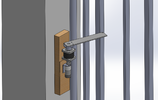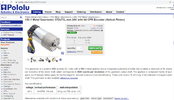Iawia
Member
Hi All,
I am attempting to open a driveway gate with a 24v motor amplified by a 10:1 gear train to get me to 500 kg-cm of torque. I was told I needed an H-bridge for the bi-directional motor control. The motor stall current is 3A, so most motor drivers I have seen can do up too 2.6 continuous current, 3A transient current, so I guess these drivers will not work.
My questions regarding this setup are:
1) I was looking at this controller (https://www.sparkfun.com/datasheets/Robotics/L298_H_Bridge.pdf). What were to happen if the motor exceeded 3A maximum? Does this destroy the controller or does the controller sense this problem and loop out? What precautions can be done to ensure the controller never goes above 2.6 A continuous? I assume i cannot use this since my motor stall current is 3A.
2) I found a controller that can do more than 3A (Jrk G2 24v13A) but it is a hefty $140. Before I make this purchase I want to discuss with y'all regarding this! (I still want to shut down if amperage gets out of control here and i'm not sure how too do that).
I will use a raspberry pi to provide the logic to the controller and eventually RF control. I am just a knowledgeable hobbyist so I feel quite inadequate when it comes to circuits. Any recommendations or assertions you can provide regarding my general mechanical or electrical assembly are welcome.
13 Amp Mtr Controller
37D 150:1 Gear Motor
Thank you! You guys are the best.
ps. I will add a chain to the end of the armature to pull the gate closed in clockwise operation. Counter clockwise operation, the arm will push the gate open.
I am attempting to open a driveway gate with a 24v motor amplified by a 10:1 gear train to get me to 500 kg-cm of torque. I was told I needed an H-bridge for the bi-directional motor control. The motor stall current is 3A, so most motor drivers I have seen can do up too 2.6 continuous current, 3A transient current, so I guess these drivers will not work.
My questions regarding this setup are:
1) I was looking at this controller (https://www.sparkfun.com/datasheets/Robotics/L298_H_Bridge.pdf). What were to happen if the motor exceeded 3A maximum? Does this destroy the controller or does the controller sense this problem and loop out? What precautions can be done to ensure the controller never goes above 2.6 A continuous? I assume i cannot use this since my motor stall current is 3A.
2) I found a controller that can do more than 3A (Jrk G2 24v13A) but it is a hefty $140. Before I make this purchase I want to discuss with y'all regarding this! (I still want to shut down if amperage gets out of control here and i'm not sure how too do that).
I will use a raspberry pi to provide the logic to the controller and eventually RF control. I am just a knowledgeable hobbyist so I feel quite inadequate when it comes to circuits. Any recommendations or assertions you can provide regarding my general mechanical or electrical assembly are welcome.
13 Amp Mtr Controller
37D 150:1 Gear Motor
Thank you! You guys are the best.
ps. I will add a chain to the end of the armature to pull the gate closed in clockwise operation. Counter clockwise operation, the arm will push the gate open.




